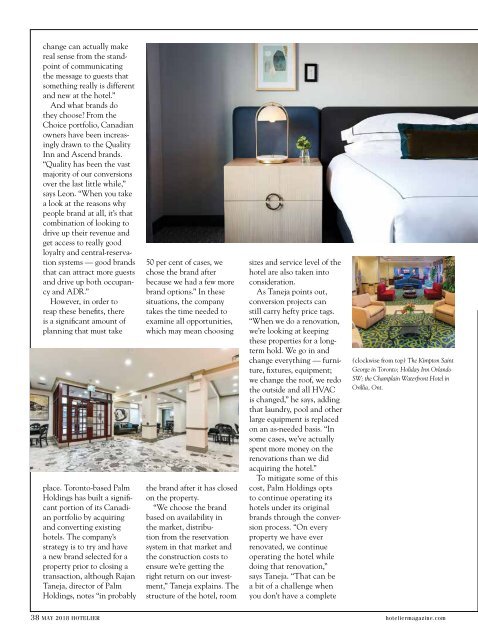May 2018 Digital Issue
Create successful ePaper yourself
Turn your PDF publications into a flip-book with our unique Google optimized e-Paper software.
change can actually make<br />
real sense from the standpoint<br />
of communicating<br />
the message to guests that<br />
something really is different<br />
and new at the hotel.”<br />
And what brands do<br />
they choose? From the<br />
Choice portfolio, Canadian<br />
owners have been increasingly<br />
drawn to the Quality<br />
Inn and Ascend brands.<br />
“Quality has been the vast<br />
majority of our conversions<br />
over the last little while,”<br />
says Leon. “When you take<br />
a look at the reasons why<br />
people brand at all, it’s that<br />
combination of looking to<br />
drive up their revenue and<br />
get access to really good<br />
loyalty and central-reservation<br />
systems — good brands<br />
that can attract more guests<br />
and drive up both occupancy<br />
and ADR.”<br />
However, in order to<br />
reap these benefits, there<br />
is a significant amount of<br />
planning that must take<br />
place. Toronto-based Palm<br />
Holdings has built a significant<br />
portion of its Canadian<br />
portfolio by acquiring<br />
and converting existing<br />
hotels. The company’s<br />
strategy is to try and have<br />
a new brand selected for a<br />
property prior to closing a<br />
transaction, although Rajan<br />
Taneja, director of Palm<br />
Holdings, notes “in probably<br />
50 per cent of cases, we<br />
chose the brand after<br />
because we had a few more<br />
brand options.” In these<br />
situations, the company<br />
takes the time needed to<br />
examine all opportunities,<br />
which may mean choosing<br />
the brand after it has closed<br />
on the property.<br />
“We choose the brand<br />
based on availability in<br />
the market, distribution<br />
from the reservation<br />
system in that market and<br />
the construction costs to<br />
ensure we’re getting the<br />
right return on our investment,”<br />
Taneja explains. The<br />
structure of the hotel, room<br />
sizes and service level of the<br />
hotel are also taken into<br />
consideration.<br />
As Taneja points out,<br />
conversion projects can<br />
still carry hefty price tags.<br />
“When we do a renovation,<br />
we’re looking at keeping<br />
these properties for a longterm<br />
hold. We go in and<br />
change everything — furniture,<br />
fixtures, equipment;<br />
we change the roof, we redo<br />
the outside and all HVAC<br />
is changed,” he says, adding<br />
that laundry, pool and other<br />
large equipment is replaced<br />
on an as-needed basis. “In<br />
some cases, we’ve actually<br />
spent more money on the<br />
renovations than we did<br />
acquiring the hotel.”<br />
To mitigate some of this<br />
cost, Palm Holdings opts<br />
to continue operating its<br />
hotels under its original<br />
brands through the conversion<br />
process. “On every<br />
property we have ever<br />
renovated, we continue<br />
operating the hotel while<br />
doing that renovation,”<br />
says Taneja. “That can be<br />
a bit of a challenge when<br />
you don’t have a complete<br />
(clockwise from top) The Kimpton Saint<br />
George in Toronto; Holiday Inn Orlando<br />
SW; the Champlain Waterfront Hotel in<br />
Orillia, Ont.<br />
38 MAY <strong>2018</strong> HOTELIER hoteliermagazine.com


















